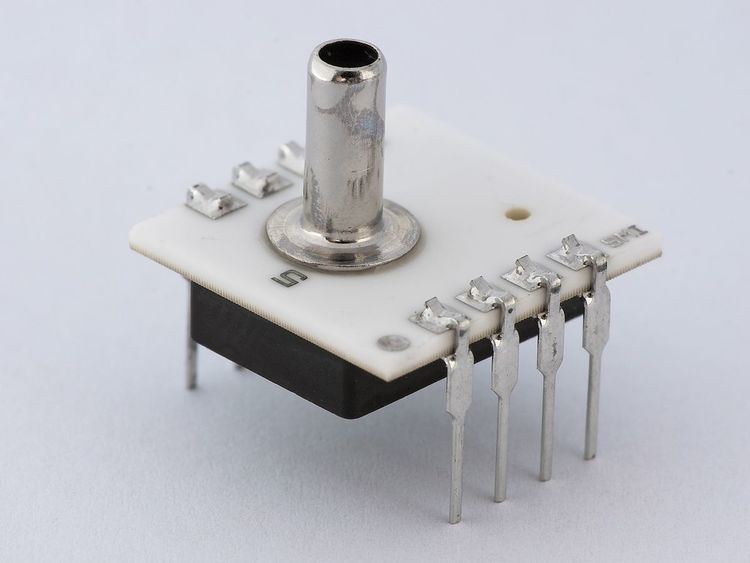 | ||
Some pressure sensors, such as those found in some traffic enforcement cameras, function in a binary (off/on) manner, i.e., when pressure is applied to a pressure sensor, the sensor acts to complete or break an electrical circuit. These types of sensors are also known as a pressure switch.
Contents
Types of pressure measurements
Pressure sensors can be classified in terms of pressure ranges they measure, temperature ranges of operation, and most importantly the type of pressure they measure. Pressure sensors are variously named according to their purpose, but the same technology may be used under different names.
This sensor measures the pressure relative to perfect vacuum.
This sensor measures the pressure relative to atmospheric pressure. A tire pressure gauge is an example of gauge pressure measurement; when it indicates zero, then the pressure it is measuring is the same as the ambient pressure.
This term can cause confusion. It may be used to describe a sensor that measures pressures below atmospheric pressure, showing the difference between that low pressure and atmospheric pressure (i.e. negative gauge pressure), but it may also be used to describe a sensor that measures low pressure relative to perfect vacuum (i.e. absolute pressure).
This sensor measures the difference between two pressures, one connected to each side of the sensor. Differential pressure sensors are used to measure many properties, such as pressure drops across oil filters or air filters, fluid levels (by comparing the pressure above and below the liquid) or flow rates (by measuring the change in pressure across a restriction). Technically speaking, most pressure sensors are really differential pressure sensors; for example a gauge pressure sensor is merely a differential pressure sensor in which one side is open to the ambient atmosphere.
This sensor is similar to a gauge pressure sensor except that it measures pressure relative to some fixed pressure rather than the ambient atmospheric pressure (which varies according to the location and the weather).
Pressure-sensing technology
There are two basic categories of analog pressure sensors,
Force collector types These types of electronic pressure sensors generally use a force collector (such a diaphragm, piston, bourdon tube, or bellows) to measure strain (or deflection) due to applied force over an area (pressure).
Other types
These types of electronic pressure sensors use other properties (such as density) to infer pressure of a gas, or liquid.
Applications
There are many applications for pressure sensors:
This is where the measurement of interest is pressure, expressed as a force per unit area. This is useful in weather instrumentation, aircraft, automobiles, and any other machinery that has pressure functionality implemented.
This is useful in aircraft, rockets, satellites, weather balloons, and many other applications. All these applications make use of the relationship between changes in pressure relative to the altitude. This relationship is governed by the following equation:
This equation is calibrated for an altimeter, up to 36,090 feet (11,000 m). Outside that range, an error will be introduced which can be calculated differently for each different pressure sensor. These error calculations will factor in the error introduced by the change in temperature as we go up.
Barometric pressure sensors can have an altitude resolution of less than 1 meter, which is significantly better than GPS systems (about 20 meters altitude resolution). In navigation applications altimeters are used to distinguish between stacked road levels for car navigation and floor levels in buildings for pedestrian navigation.
This is the use of pressure sensors in conjunction with the venturi effect to measure flow. Differential pressure is measured between two segments of a venturi tube that have a different aperture. The pressure difference between the two segments is directly proportional to the flow rate through the venturi tube. A low pressure sensor is almost always required as the pressure difference is relatively small.
A pressure sensor may also be used to calculate the level of a fluid. This technique is commonly employed to measure the depth of a submerged body (such as a diver or submarine), or level of contents in a tank (such as in a water tower). For most practical purposes, fluid level is directly proportional to pressure. In the case of fresh water where the contents are under atmospheric pressure, 1psi = 27.7 inH20 / 1Pa = 9.81 mmH20. The basic equation for such a measurement is
where P = pressure, ρ = density of the fluid, g = standard gravity, h = height of fluid column above pressure sensor
A pressure sensor may be used to sense the decay of pressure due to a system leak. This is commonly done by either comparison to a known leak using differential pressure, or by means of utilizing the pressure sensor to measure pressure change over time.
Piezoresistive transducers configured as Wheatstone bridges often exhibit ratiometric behavior with respect not only to the measured pressure, but also the transducer supply voltage.
where:
Correcting measurements from transducers exhibiting this behavior requires measuring the actual transducer supply voltage as well as the output voltage and applying the inverse transform of this behavior to the output signal:
Note: Common mode signals often present in transducers configured as Wheatstone bridges are not considered in this analysis.
